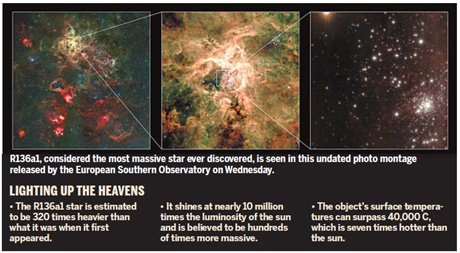 |
Large Medium Small |
Discovery sheds light on 'gaps' in Chinese astronomy
BEIJING - British scientists' recent discovery of R136a1, the most massive and brightest star ever found, has reminded Chinese stargazers of a challenge: When will China itself be able to pinpoint such a new find in deep space?
"Deep space research has come from finding out what is actually out there rather than using theory to predict what is out there, which means observation

al breakthroughs can happen only when equipped with the most advanced observation facilities and technology," said Professor Liu Xiaowei from the Kavli Institute for Astronomy and Astrophysics.
"There is still a long way for China to catch up in both aspects."
Astrophysicist Paul Crowther and his team at the University of Sheffield in northern England discovered R136a1 based on images taken by the European Southern Observatory (ESO) Very Large Telescope (VLT) based in Chile and archival data collected by NASA's Hubble Space Telescope.
The VLT is one of the world's most advanced ground-based and near-infrared optical instruments that started operating in 1998. It consists of four 8.2m telescopes and four movable 1.8m diameter Auxiliary Telescopes.
In comparison, China has no space telescopes. Its best ground-based optic telescope is a 2.4m aperture telescope in Lijiang, Yunnan province, put into operation in 2008.
Its location is also much less desirable than that of the VLT, Liu said.
Stationed in a place completely free from light pollution, VLT enjoys a sky over it so dark that on a clear moonless night it is possible to see one's shadow cast by the light of the Milky Way alone.
"In astronomical observation, less light pollution means better image quality," Liu said.
"It will take a long time for China to build an optical telescope that is comparable with the VLT," Liu said.
Within the next decade, the ESO and United States would have moved on to the next stage of development. The ESO has announced a plan to build a 42m European Extremely Large Telescope, which on completion in 2018 will be at least 100 times more sensitive than any current world-class telescope. The US is similarly working on a Thirty Meter Telescope (TMT), also scheduled for completion by 2018.
"It is almost impossible for China to catch up in the field of deep space research by working on its own," said Xue Suijian, assistant director-general of the National Astronomical Observatories of the Chinese Academy of Sciences (NAOC). "International cooperation is the fastest way for China to get a jump-start in its deep space research."
NAOC has joined the TMT project, according to Xue who leads the Chinese team in the cooperation effort.
"As an observer, China will participate in planning the development of what will be the world's most advanced and capable astronomical observatory," Xue said.